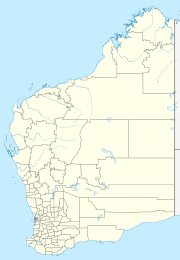Campion, Western Australia facts for kids
Quick facts for kids CampionWestern Australia |
|
|---|---|
| Established | c. 1920 |
| Postcode(s) | 6490 |
| Location | |
| LGA(s) | Shire of Nungarin |
| State electorate(s) | Central Wheatbelt |
| Federal Division(s) | Durack |
Campion is an abandoned townsite in the Wheatbelt region of Western Australia. It is located in the Shire of Nungarin on the Koorda–Bullfinch Road. Campion is situated within the area of Chandler, with the closest town being Mukinbudin.
The Campion railway station was once very close to the famous Rabbit-Proof Fence number 1.
Contents
History of Campion
Early Settlement and Naming
People started settling in the Campion area for farming in the early 1920s. Many of these settlers were migrants or soldiers who had returned from war. They worked as contractors, clearing land for the Agricultural Bank of Western Australia. After clearing the land, they often stayed to buy their own farms.
This area was first called the East Lake Brown district. Nearby Lake Brown was one of several lakes surveyed by John Septimus Roe in 1836. The name Campion was given in 1925. It honored Sir William Campion, who had just become the new governor of Western Australia.
Town Development and Growth
A state school was built in Campion in 1925. The local member of parliament, Harry Griffiths, officially opened it. About 100 people attended the opening ceremony.
The Campion townsite was officially recognized on 28 March 1928. This happened after the Wyalkatchem to Mukinbudin railway line was extended. The town was located where the railway crossed the State Barrier Fence of Western Australia. During its construction, the railway section through Campion was known as the Lake Brown to Bullfinch railway.
The Campion ward was a local area that elected one representative. This person became a councillor on the Nungarin Shire Council, which manages the local government.
Governor's Visit to Campion
Sir William Campion visited the town named after him in 1930. This was in the second-last year of his time as governor. A local schoolteacher, Eunice Bedwell, remembered his visit. She described the town at that time:
There were two simple buildings, a small general store, and an even smaller agent's office. Behind them were the usual sheds. The Governor was met by the head of the local RSL. He enjoyed a wonderful lunch at one of the farms. The farm ladies were amazing cooks, and they had plenty of eggs and cream. After lunch, they took a tour of the area. The newly farmed fields showed touches of early green crops on the rich red soil.
Why Campion Declined
Farming Challenges
In 1928, the Campion area produced a lot of wheat, about 40,000 bags. However, the local wheat industry faced big problems. Wheat prices started to fall in the late 1920s. This was followed by the start of the Great Depression in Australia, a time of severe economic hardship.
In 1932, the district also had a major problem with emus. Large numbers of emus were damaging crops. The local farmers asked the government for help. This led to a unique event known as the Emu War, where soldiers were sent to deal with the emus.
Shift to Chandler
Later, a mineral called alunite was found on the west side of Lake Campion. In 1942, a state-owned factory was built to process this mineral. A new townsite was officially created nearby at Chandler.
Because of this new development, all the growth and activities moved to Chandler. The Campion townsite was never fully developed. The local school in Campion was eventually closed. The Campion railway stop was shut down in 1956. Finally, the Campion townsite was officially removed from maps in 1972.
Environment Around Campion
A special type of carnivorous plant called Byblis rorida grows near Campion. This plant is part of the Byblidaceae family. You can find it on the shores of Lake Campion.


